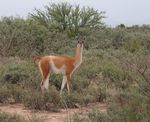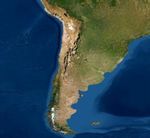Chaco Taguá Biological Corridor - Argentina - Scott Bader
←
→
Page content transcription
If your browser does not render page correctly, please read the page content below
Chaco Taguá
Biological Corridor
Registered charity no 1001291
© Juan/ FBA
Country: Argentina Project Summary
The Chaqueña ecoregion represents the second largest forest area in South America,
Partner/Organisation: with 60% of this ecoregion occurring in Argentina. Within Córdoba Province less
Fundacion Biodiversidad than 5% of native forests remain and Fundacion Biodiversidad Argentina (FBA)
Argentina (FBA) aims to create a biodiversity corridor called the “Chaco Taguá Biological Corridor”
which will protect large areas of the Chaqueña ecoregion. This corridor will connect
two protected areas within Cordoba: to the north the recently created National Park
Biome “Traslasierra” of 105,000 hectares (260,000 acres) and to the south the Natural Park
and Provincial Natural Forest Reserve “Chancaní” of 4,920 hectares (12,150 acres), as
Tropical & Subtropical Grasslands,
well as connecting areas to the north of Traslasierra to the surrounding landscape. The
Savannas & Shrublands
project has two objectives; one connecting these two parks through the land purchase
Ecoregion of three private properties with a total area of 7,474 hectares, and two, strengthening
the northern sector of the corridor with the acquisition of two further properties (of
Dry Chaco
9,566 hectares) to the north of Traslasierra National Park. WLT support will focus on
Habitats fundraising towards securing an estimated 5,316 hectares of the total project area.
Predominantly xerophytic forest Main Threats to the Area
(secondary) with further woodland and
Forest overexploitation, unplanned urbanization progress, intentional fires,
shrubland areas. The project is mostly on
indiscriminate logging for timber and charcoal production, and poaching. Further loss
flat plains of around 250 metres above
of biodiversity because of these pressures is likely to lead to a reduction in forest
sea level, but rises sharply to the east in
quality and resources and a further reduction in quality and sustainability of people’s
the Sierras de Guasapampa and Pocho
lives in this region. Around 75% of the area is under Argentina’s Red Forestry Law
ranges rising to an elevation of 1000
category, which only allows minimal activities and no forest clearance. Unfortunately,
metres.
the enforcement of this law is often ineffective and land in the project area in ‘Red’ and
‘Yellow’ protection categories has been cleared in spite of their legal classification.
Global Prioritization
Neighbours the Chancaní y Sierras de Pocho Important Bird Area (IBA).Map of the proposed Proposed Biological Corridor
purchases Proposed Traslasierra
Expansion
Protected Area
Cór oja
a
dob
i
La R
Provincial Border
Peru
Bolivia
Traslasierra Brazil
National Park
Pacific
Ocean
Argentina
Chile
Atlantic
Ocean
C
Pro hanc
vin a
cia ni 0 5 10 km
l Pa
rk
Source: Esri, Maxar, GeoEye, Earthstar Geographics, CNES/Airbus DS, USDA, USGS, AeroGRID, IGN, and the GIS User Community
Key Species 1
Chaco Guanaco
Chacoan Peccary (Catagonus wagneri, EN); Chaco Guanaco (Lama guanicoe, LC);
Crowned Eagle (Buteogallus coronatus, EN); Yellow Cardinal (Gbiertrix cristata, EN);
Chalchalero Viscacha Rat (Salinoctomys loschalchalerosorum, CR), Berg’s Tuco-tuco
(Ctenomys bergi, VU).
Biodiversity
The project will protect the southernmost and possibly genetically isolated population
of the globally endangered Chaco Peccary and the only known population of Chaco
Guanaco in Argentina. Studies in Traslasierra National Park have recorded 229 species
of birds, 35 species of mammals, and 43 species of amphibians and reptiles. Mammals
include two endemic rodent specie for Argentina, the Vizcacha Viscacha rat and Berg’s
Tuco-tuco.
© Tams Waller/ FBA
Local Communities
Chacoan Peccary The properties of the Tegua Biological Corridor are large farming estates (estancias)
owned by private landowners. There are no villages within the planned corridor.
Surrounding the corridor there are around 23 communities of various size, from a few
families to several thousand inhabitants. The region is one of the poorest in Argentina
and productive activities are mainly marginal, subsistence level livestock (goat) rearing.
Secondary activities include agriculture, collecting firewood, collecting and using
medicinal and aromatic plants, and natural dyes. The project will protect the forest on
which these communities depend, and FBA will work to ensure communities are able to
continue to sustainably use and benefit from the corridor.
Partner/NGO
Fundacion Biodiversidad Argentina (FBA) is an NGO founded in 1999 and dedicated to
nature conservation. They have worked with WLT since 2012 and we have collaborated
on projects in Misiones (Emerald Green Corridor) and Jujui (El Pantanoso). FBA’s
projects outside of WLT’s support include developing management plans for threatened
©Tim Vickers
species such as the Yellow Anaconda, regulating the trade and promoting sustainable
use of the hardwood species Bulnesia sarmientoi, and the use of wool from Llama,
1
International Union for the Conservation of
Alpaca, Guanaco and Vicúna through their Camelid Programme.
Nature (IUCN) Red List of Threatened species
includes categories of Critically Endangered (CR),
Endangered (EN), Vulnerable (VU), Near Threatened
(NT) and Least Concern (LC)
World Land Trust, Blyth House, Bridge Street, Halesworth, Suffolk IP19 8AB, UK Tel: 01986 874422 Fax: 01986 874425 Email: info@worldlandtrust.org
Registered Charity 1001291You can also read






















































